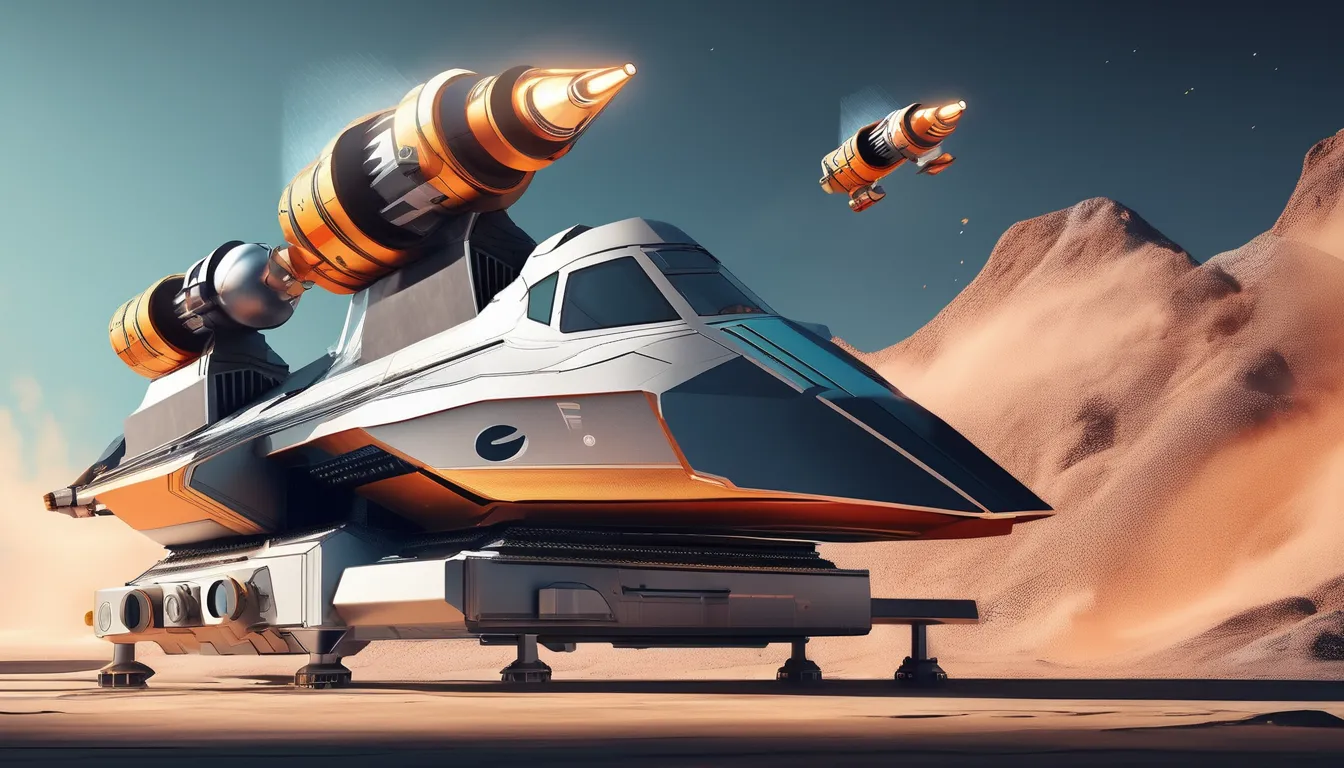How Thruster Blast Systems Are Revolutionizing the Future of Space ExplorationHow Thruster Blast Systems Are Revolutionizing the Future of Space Exploration

As you consider the future of space exploration, you're likely thinking about the technologies that will make it possible to travel farther and more efficiently. One key innovation is the Thruster Blast System, which promises to revolutionize the way spacecraft propel themselves through space. By leveraging advanced propulsion technologies, these systems can achieve higher specific impulse and power efficiency than traditional systems. But what exactly makes them so effective, and how will they be used in various space missions? The answer lies in understanding the technology behind Thruster Blast Systems and their potential applications.
Thruster Blast System Technology
Implementing Thruster Blast System Technology requires a deep understanding of its core components and operating principles. You'll be working with a complex system that involves a combination of electrical and mechanical components, including power processing units, propellant management systems, and the thruster itself.
The power processing unit converts electrical energy into a form that's suitable for the thruster, while the propellant management system controls the flow of fuel and oxidizer to the thruster.
As you delve deeper into the technology, you'll need to understand the different types of thrusters that can be used in a Thruster Blast System, including Hall effect thrusters, ion thrusters, and arcjets.
Each type of thruster has its own strengths and weaknesses, and you'll need to choose the one that's best suited for your specific application.
You'll also need to consider the system's power requirements, as well as its mass and volume constraints.
Advantages Over Traditional Propulsion
When designing a propulsion system for space missions, you often find yourself weighing the benefits of traditional propulsion against those of newer, more advanced technologies like Thruster Blast Systems. Traditional propulsion systems, such as chemical rockets, have been used for decades, but they have significant limitations, including high mass, low efficiency, and limited maneuverability. Thruster Blast Systems, on the other hand, offer several advantages that make them an attractive alternative.
|
Characteristics |
Traditional Propulsion |
Thruster Blast Systems |
|---|---|---|
|
Specific Impulse |
Limited to 450 seconds |
Up to 3,000 seconds |
|
Power Efficiency |
20-30% efficient |
50-60% efficient |
|
Mass Fraction |
High mass fraction, reducing payload capacity |
Low mass fraction, increasing payload capacity |
These advantages translate to significant benefits for space missions, including longer mission durations, increased payload capacity, and reduced launch costs. With Thruster Blast Systems, you can achieve more efficient and effective propulsion, enabling you to explore space more easily and cost-effectively. By considering these advantages, you can make informed decisions when designing your next space mission.
Space Mission Applications
With the advantages of Thruster Blast Systems established, it's clear that these technologies can significantly enhance space mission capabilities. You'll find that Thruster Blast Systems can be applied to a variety of space missions, including interplanetary travel, satellite propulsion, and deep space exploration.
For instance, these systems can be used to propel spacecraft to other planets, such as Mars, more efficiently and effectively. This is especially important for long-duration missions where fuel efficiency is critical.
Thruster Blast Systems can also be used to maintain satellite orbits, reducing the need for traditional propulsion systems and extending the lifespan of satellites.
Additionally, these systems can be used to propel spacecraft to higher speeds, enabling them to reach distant destinations more quickly. This can be particularly beneficial for missions that require rapid response times, such as asteroid deflection or comet exploration.
As you consider the possibilities, it's evident that Thruster Blast Systems can play a critical role in advancing space exploration and expanding our understanding of the universe.
Challenges and Limitations
Although Thruster Blast Systems have shown great potential in space mission applications, several challenges and limitations must be addressed to fully harness their capabilities. You'll need to consider issues like fuel efficiency and thrust-to-power ratios.
As you explore the use of Thruster Blast Systems, you'll find that they can be power-hungry, which can limit their use in long-duration missions. Additionally, the high voltage requirements for these systems can be a challenge, especially when working with limited power sources.
You'll also need to consider the impact of degradation on system performance over time. Thruster Blast Systems can experience erosion of their electrodes, which can reduce their efficiency and overall lifespan.
Furthermore, the systems' high temperatures and radiation exposure can cause additional wear and tear. As you work to implement Thruster Blast Systems in your space mission, you'll need to balance these limitations against the benefits they provide. By understanding these challenges, you can design more effective and efficient systems that meet the demands of your mission.
Future Thruster System Developments
Thruster Blast Systems' limitations and challenges serve as a catalyst for innovation, pushing researchers and engineers to develop more efficient and sustainable technologies. As you explore the future of space exploration, it's essential to understand the advancements being made in thruster system development.
|
Development Area |
Current Status |
Future Goals |
|---|---|---|
|
Electric Propulsion |
Efficient Thruster finance small spacecraft, but limited by power sources |
Increase power output and reduce mass for larger spacecraft |
|
Nuclear Propulsion |
Theoretical designs exist, but pose significant safety concerns |
Develop safe and compact nuclear reactors for propulsion |
|
Advanced Ion Engines |
Currently in use, but require significant resources |
Improve efficiency and reduce resource requirements for longer missions |
|
In-Orbit Assembly |
Limited by robotic capabilities and material transportation |
Develop advanced robotics and 3D printing for in-orbit assembly of thruster systems |
As you consider the future of space exploration, it's clear that thruster system developments will play a crucial role in overcoming the challenges of deep space travel. By investing in these technologies, you'll be contributing to a more sustainable and efficient future for space exploration.
Frequently Asked Questions
Can Thruster Blast Systems Be Used in Commercial Airlines?
You wonder if thruster blast systems can power commercial airlines. They're unlikely to replace traditional engines, as they're designed for short, intense bursts, but you could use them to assist takeoff or reduce emissions during landing.
How Does Noise Pollution Affect Thruster System Operations?
You might not think noise pollution impacts systems like thrusters, but it can actually affect their operations. Noise interference can disrupt thruster control systems, and vibrations can damage components, so noise reduction is crucial.
Are Thruster Blast Systems Reusable on Space Missions?
You're wondering if thruster blast systems are reusable on space missions. Yes, you can reuse them, as they're designed to withstand multiple firings, but you'll need to refuel and recalibrate them between uses for optimal performance.
Can Thruster Blast Systems Be Used for Interstellar Travel?
You might wonder if thruster blast systems can propel spacecraft across vast interstellar distances. While they're not yet powerful enough, researchers are exploring innovative designs that could potentially make interstellar travel a reality in the future.
What Are the Environmental Impacts of Thruster System Production?
You're considering the environmental footprint of thruster system production. Manufacturing requires energy, rare earth metals, and specialized materials, generating greenhouse gas emissions, hazardous waste, and resource depletion, all of which have a significant ecological impact on Earth.
Conclusion
As you look to the future of space exploration, it's clear that Thruster Blast Systems are leading the charge. With their higher specific impulse and power efficiency, these systems are set to revolutionize the way we travel through space. You'll play a role in shaping this future, whether it's by investing in research, designing new systems, or pushing the boundaries of what's possible in space. The possibilities are endless, and the future is bright.

